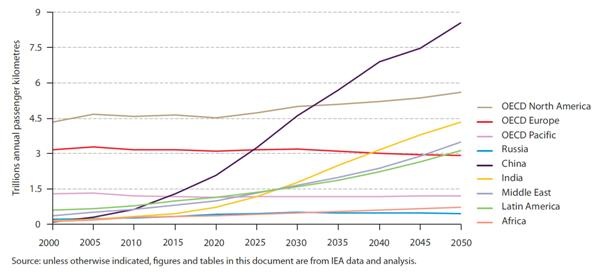Why oil and cars can't cut it
Our chart of the week is drawn from the International Energy Agency’s recent report, A Tale of Renewed Cities, which focuses on improving the energy efficiency of urban transportation.
What the chart below illustrates is that even through the amount of urban travel in developed world (OECD) cities is largely stabilising, billions of people in China, India and the rest of the developing world hitting the road will mean a huge surge in motor vehicle travel.
Expected urban private motorised travel (in passenger kilometres)

By 2050, around 6.3 billion people will live in an urban area. The IEA projects that urban passenger travel under a business-as-usual scenario will more than double globally by 2050, and ten-fold growth is likely in areas such as India and South-East Asia. This growth means that global annual urban transport energy consumption could rise by 80 per cent over 2010 levels by 2050, despite expected vehicle technology and fuel-economy improvements.
If we don’t change our approach to transport and urban design, this will have incredible consequences, not just in terms of carbon emissions, but also human respiratory health, oil prices, wasted travel time and overall economic productivity.
We simply cannot afford a path of continuing our heavy reliance on oil fuelled motor-vehicles.
The International Energy Agency observes:
“In effect, the world has reached a turning point. The 19th and 20th centuries changed how we move through rapid transit and private motorisation. The 21st century now must address how to move people and goods most efficiently in an energy-, budget-, time- and space-constrained world.
This transition will require more than advances in vehicle technologies: fuel efficiency improvements alone cannot mitigate the consequences of a world in which nearly 70 per cent of all movements will be made by motorised roadway travel in more than three billion vehicles in 2050. Instead, 21st century travel efficiency will require shifts in how we perceive, design, operate and manage the world’s transport systems.”
The ad hoc, laissez-faire approach to managing the growth of cities in places like the US and Australia, which relied heavily on roads, simply will not cut it for the rest of the world. There are just too many people to move around.
















